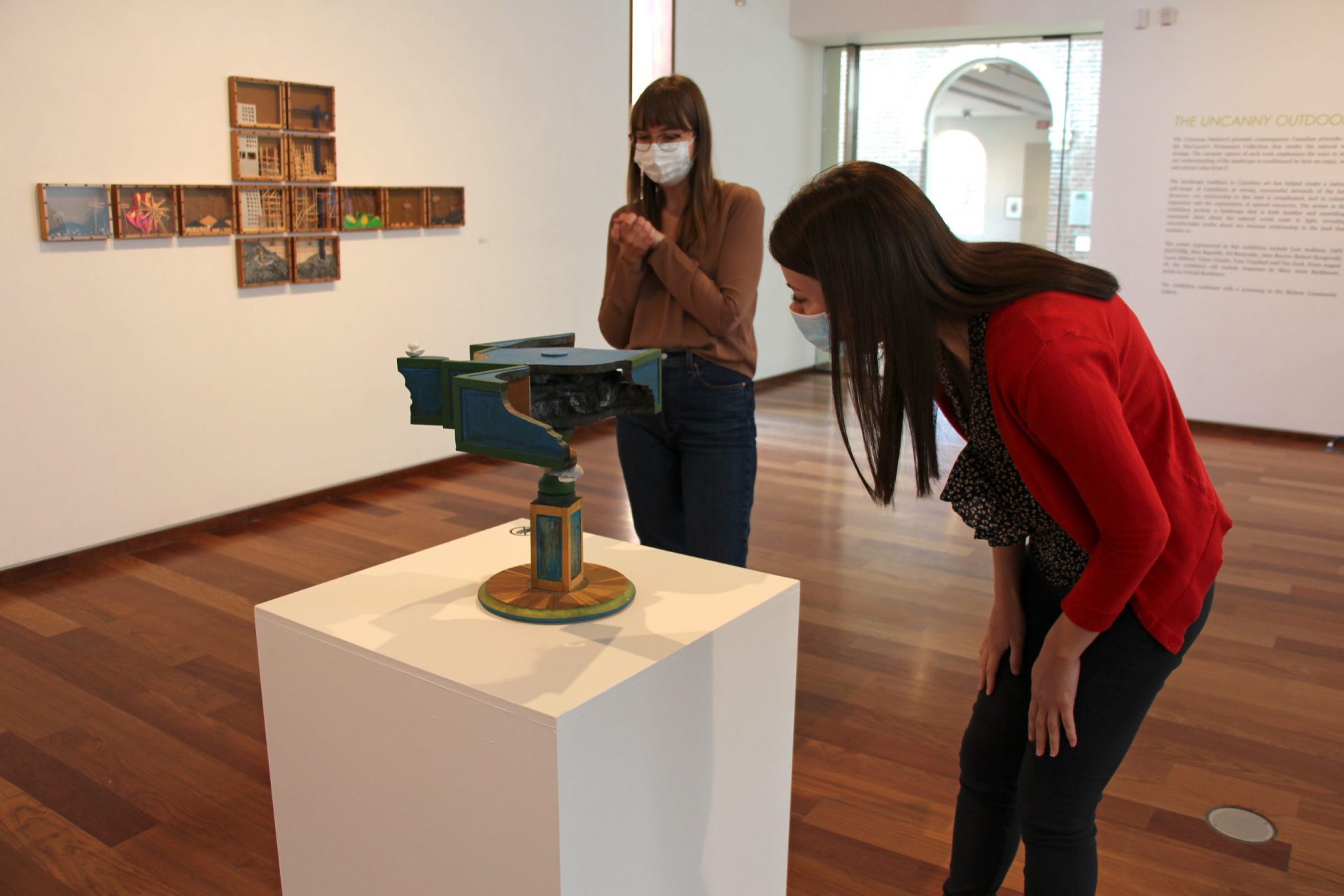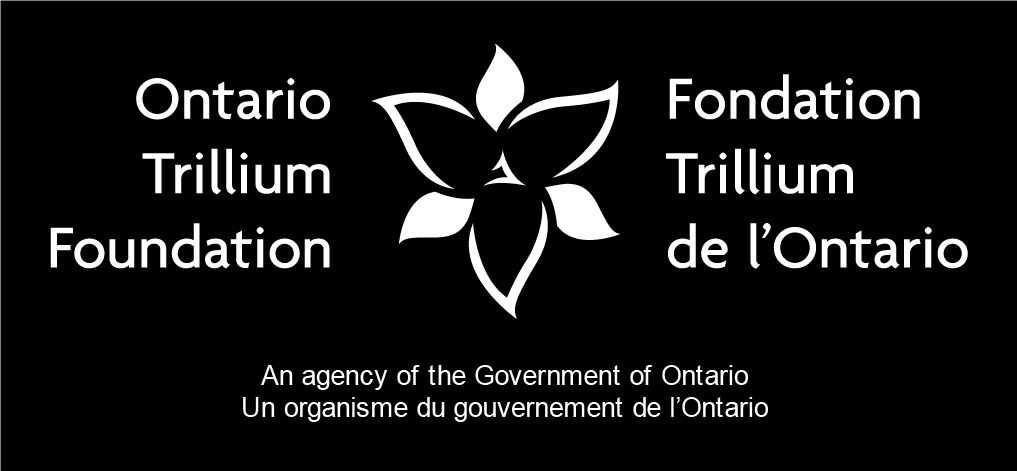Today this social media manager got to chat with Acting Director/Senior Curator Emily McKibbon to delve a little deeper into The Uncanny Outdoors. Walking through the Janice Laking Gallery together, I had a chance to hear her thoughts on the exhibition and learn some of the nuances that bring a show like this together. Read all about it in my Q&A with Emily!
Christine: So how did you choose different bodies of work for this exhibition?
Emily: Whenever we plan an exhibition, we always begin with a “curatorial thesis.” A curatorial thesis is pretty similar to an essay’s thesis: it’s an idea that we’re interested in teasing out through various bodies of work, and the idea is often generated as a response to artworks that we’ve seen and that we’re still puzzling through.
With this exhibition, I was curious about how contemporary artists can challenge us to see the landscape in different and surprising ways. The landscape—and our perception of it—is never neutral. Imagine a golf course: to a golfer, it’s paradise. For someone who’s concerned about pesticide use or water conservation, it’s a problem. And those different perspectives extend to the non-human world: a hawk sees a golf course as an opportunity to spot their prey with very little obstructing their view; for a wild rabbit, it’s a pretty vulnerable and scary place. We can get a little stuck in how we see the landscape, and artists are great at presenting new opportunities to view the same place with different eyes.
Once I had that curatorial thesis—how do artists challenge us to see the landscape in new ways?—the selection of different artworks and bodies of work became much simpler. We have roughly 4000 works in our contemporary Canadian collection, and a strong thesis allows us to narrow our focus and choose work that advances an idea and hangs together cohesively.
Christine: A number of works in the show are labelled as a “chromogenic print”. What exactly is that?
Emily: A chromogenic print is a very specific term for a colour photograph that is printed using the chromogenic process. It’s not a digital photograph, even if it’s derived from a digital file—and they often are, these days—but a “real” photograph formed from three layers of silver halides and dye couplers, a process that has been in use since the late 1930s. It’s your pretty standard analogue colour photograph.
We call the labels beside artwork “tombstone” labels because they kind of look like one. Tombstone labels include the artist’s name, the artwork’s title, the date the artwork was made, the medium, and information on how the museum came to own or borrow it, among other things—all in a strictly standardized format. The medium field describes what materials and processes were used to create the artworks, and in photography this field can get a little… technical. We use the Getty’s Art and Architecture Thesaurus when we generate tombstone labels to ensure that there is consistency across different museums and galleries. Chromogenic print is the term used most widely for this type of colour photograph, and it differentiates chromogenic prints from the wide range of colour photographic processes that have existed since the first discovery of a rudimentary colour photographic process in 1851!
Jane Buyers, The Road Into/Out of Town, 1982, Mixed media. Collection of the MacLaren Art Centre. Gift of Janusz Dukszta
Christine: The installation by Jane Buyers is really fun to look at, but I’m not sure I fully understand what’s going on there. Could you tell me a little more about her work?
Emily: The Road Into/The Road Out Of Town (1982) is a “miniature environment” by Jane Buyers, who was then based in Toronto (she lives and works in Elmira, these days). It’s a gridded installation comprised of fourteen discrete shadowboxes, representing—at centre—the building of a skyscraper, from its far reaches into the sky to its steel girders and concrete footings in the ground. Flanked on either side of this central column are roads leading out and into the suburbs, complete with the rooftops you can only just glimpse over the concrete sound barriers along the highway and a suburban fairground (imagine the CNE as you’re driving west along the Gardiner Expressway). Buyers’ is a materially rigorous artist, and this early work incorporates clay, wood, metal, tar and cloth. It speaks to memory, experience and the potential for transformation in its evocation of a shifting urban landscape. Cityscapes are landscapes, too!
Christine: At first glance, this show strikes me as beautiful, but there’s also a slight sense of unease or moodiness detectable when you realize the work is speaking to our human impact on the environment. Can you tell me, what are the main ideas people should take away from this exhibition?
Emily: I hope that people will take away a desire to look very closely at the landscapes that they take for granted, and to perhaps think about the role that they play in making, shifting or threatening that landscape simply by living and working in its proximity. I’m particularly drawn to the relationship between Ed Burtynsky’s Nickel Tailings #37, 1996 and Takao Tanabe’s Prairie Hills 7/10, 1970, which are presented next to each other on the southern wall of the Janice Laking Gallery. Burtynsky’s work shows the devastation that mining has had on the waterways near Sudbury, while Tanabe presents a Prairie landscape that exists seemingly without human intervention. Both demonstrate something ineffable about the natural world: it is both extraordinarily threatened by us, and infinitely larger and more powerful than us. We need to get to a place where we can see the landscape for more than what it materially brings to us, but as something that is precious and requires careful stewardship. Seeing things anew is only one step in this process, and artists have always been uniquely capable of offering new perspectives.
Christine: Thank you, Emily, for allowing me to pick your brain in the name of social media! Don’t miss The Uncanny Outdoors, which will be on display at the MacLaren through to November 22.











